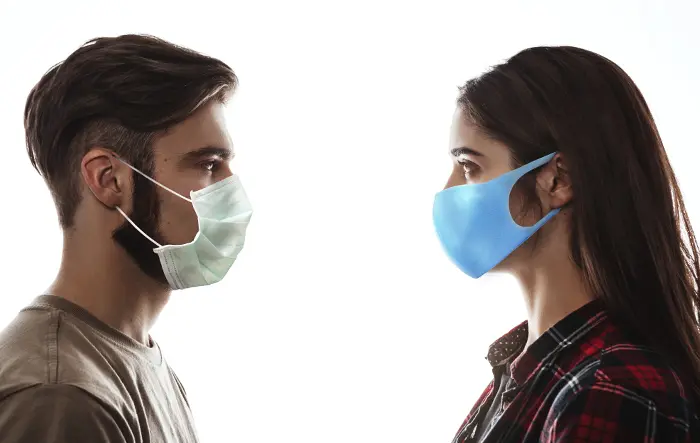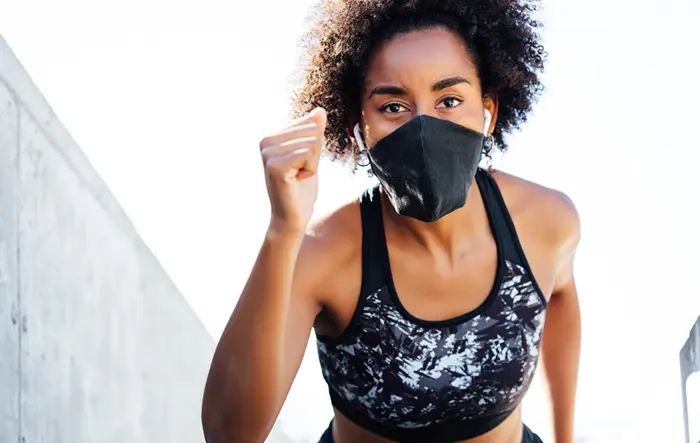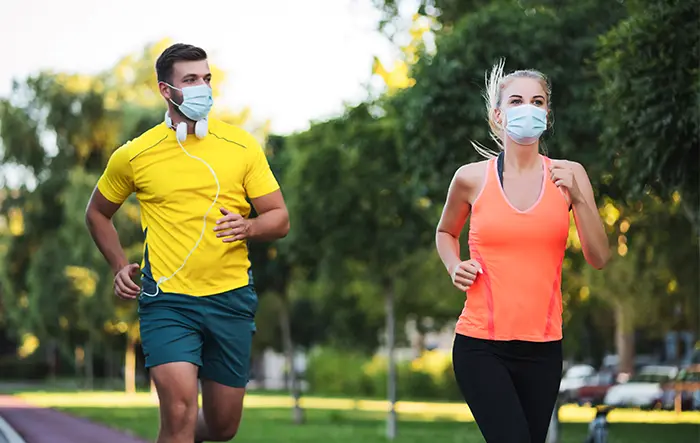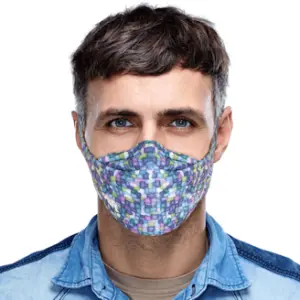One of the hardest things to do during this pandemic has been working out. Gyms are closed across the country, and for good reason: enclosed spaces with lots of people accumulating moisture and sharing machinery are a breeding ground for spreading disease. Between a slow trickle of information about what is and isn’t dangerous and the wide variety of strategies available, it’s been difficult to keep up that exercise habit.
Perhaps, now that the new year is here, the vaccine is on its way, and the weather is turning pleasant again, it’s time to start figuring out how to work out.
One thing is clear: in public space, it’s still a good idea to wear a mask, vaccine or not. According to the CDC and the Cleveland Clinic, masks are essential even with a vaccine available, for several reasons.
- The vaccine takes a while to fully take effect. You’re not immune once you get the shot; you need to give your body time to figure out what’s going on and build the proper immune response.
- The vaccine isn’t 100% effective. The best vaccines are 95% effective, but you (or others around you) can still fall into that 5%.
- The jury is still out on whether or not vaccinated people can spread the disease without knowing it. The vaccine has only been tested to see whether or not it prevents you from getting sick, not if it can prevent you from spreading the sickness.
- Plenty of people can’t be vaccinated, for health reasons. Pregnant women may opt-out, as can people who have allergic reactions to the vaccine, as rare as they are.
So, if you want to start hitting a gym as it opens back up, or working out with a group in the park, or picking up running at the track, there are options available to you. The key, however, is that you still need to be wearing a mask.
The Problem with Masks for Exercise
The problem with masks, while you’re exercising, is specifically that second part: the exercise. Masks force you to breathe through their surface. If the mask is too dense and not tightly pressed to the face, your breath leaks out around the mask rather than through it. That means you’re breathing in and out unrestricted, which is definitely more comfortable, but dramatically less effective.
Think of it as similar to a water filter. If a filter gets clogged, water can build up behind it and spill out around it. You wouldn’t drink that water; it’s unfiltered, potentially contaminated. The same thing happens with air.
A mask that is perfectly fine for casual use, while at work or while shopping, for example, might fall flat under the higher pressure of exercise. You breathe faster, harder, heavier when you work out, and your mask might be more restrictive to the greater airflow.

This might prove that your mask leaks or it might restrict the amount of oxygen you take in, which can have detrimental effects on both your workout and your body as a whole.
On the other hand, if your mask is too thin, it won’t really do much for you. A mask that is too thin will fail to filter anything, and can even get in your mouth when you breathe, which is unpleasant, to say the least. It can also be a contamination risk in some extreme cases.
The best thing to do is avoid the problem entirely. You can work out without wearing a mask, so long as you take other precautions. A home gym allows you to work out without exposing anyone else or being exposed to anyone else. Running on trails or otherwise alone on a sidewalk is fine; you’re not in other peoples’ space or breathing their air, so you’re not going to be contaminated.
Of course, we can’t all bask in this luxury. Plenty of people don’t have space or the resources to set up a home gym, and many of us live in crowded cities where the only places to run are on treadmills or enclosed tracks. In these situations, you’ll likely want a mask.
You can always keep putting your workouts on hold, or avoiding the gym as much as possible. There are plenty of alternative bodyweight exercises you can do at home to keep you from needing to go to the gym, and it doesn’t take much space to do them.

For those of us who have no option but to work out in a space with other people, though, we have to wear our masks. The only question is, what should we look for in a mask for working out?
Workout Mask Considerations
There are a lot of different factors that go into making a mask good for working out. Let’s examine each of them.
Breathability vs protection. The quality of a filter is measured in how much it prevents from passing through it, while still allowing what is supposed to get through it. This is difficult with something like COVID-19 because the actual virus is smaller than the air you need to breathe. You can’t block the virus without blocking air. Fortunately, the virus isn’t free-flying; it is carried in droplets of moisture, which are much larger than air and can be caught in a filter, or even in many fabrics.

When working out, you want a mask that is the right balance of breathable and protective. Too protective and you won’t be able to breathe while you’re working out. Too breathable and it won’t protect you or the people around you from spreading the disease.
There’s no one right answer here. In part, it depends on the kind of workout you’re doing. Someone lifting weights is going to have different needs than someone running on a treadmill. Even different weaves of the same fabric can have different breathability levels, so it’s impossible to give one specific recommendation.
Filter vs no filter. A filter adds to the breathability versus protection problem. A filter could restrict air, especially if it’s an older filter that you’ve used a bit already. It enhances protection but might hurt breathability depending on the brand. On the other hand, some kinds of fabric masks are not filtering enough on their own, and require a filter if they want to have any effect at all. This comes down to the kind of mask you’re using, specifically, and how it is designed.

You may consider double-masking, especially if you’re using surgical masks or otherwise non-filtering or thin fabric masks. It’s hard to recommend double-masking, however. It’s difficult to do right, it can be uncomfortable, and it (of course) requires purchasing more masks. If you want to try it, however, follow these tips:
- Use a cloth mask as an outer layer and a surgical mask as an inner layer. Other combinations might not work as well, or don’t add any benefit, like two surgical masks, or wearing anything under an N95 mask that compromises the face seal.
- Test your mask combination at home before going to the gym. Jog in place to build up your heart rate and breathe heavily, and make sure you can breathe with them both in place.
- Make sure you always use clean/fresh masks each time you wear them. Old, dirty masks should be considered contaminated and either cleaned or disposed of.
Fabric composition. Different kinds of fabrics (and different weaves of different fabrics) have an impact on both how breathable and how filtering the fabric is. The CDC recommends cotton, primarily. Spandex, silk, and polypropylene are all good options as well but may need to be multi-layered (either within a single mask or with multiple masks) to be effective. Other fabrics, like denim or vinyl, will not work as a mask material. Luckily, the CDC is working on rules and a testing process it can use to certify fabric masks, so you will soon be able to shop for cloth masks that are CDC-certified similar to N95s.
Disposable vs. reusable. The choice between disposable masks and reusable masks is one we’ve all had to make, but the workout situation makes it trickier. Working out means you’ll be sweating and breathing heavily, which builds on and in your mask much more quickly than through normal use.

Disposable masks have the added benefit of being able to pull them off, throw them away, and not care about them once they get soaked. However, as they build up moisture, they may be harder to breathe through, which will typically be during the mid-point of your workout. Consequently, you may be forced to go through 2-3 masks during a single workout, which dramatically increases your mask consumption. For people with environmental concerns or budgetary limits, this can be terrible.
Reusable masks have the same problem, but you might need to carry a second or third mask to swap to when your first mask is soaked, but also a container of some kind (be it a zipper bag, a plastic case, or another mask container) so you can store the contaminated mask until you can wash it. Just shoving it in a purse or pocket is generally a bad idea. You also need to make sure to clean your masks between every workout, which might be every single day for some people.
Ease of cleaning and sanitizing. Disposable masks cannot be cleaned. Reusable masks can be cleaned, but you have to clean them properly to ensure that they don’t deteriorate and that they are actually sanitized. For many mask styles, this might be as simple as tossing them in the wash with detergent or hand-washing them with soap and warm water.

The biggest thing to remember here is that your masks need to be cleaned after every use. It might be a good idea to pick up multiple extra masks, particularly if you work out every day; a new mask for every day of the week might sound like overkill, but you may even need more than that. Consider one mask for work each day. One different mask for working out each day. Another mask for running errands, a couple of times per week. Now you’re looking at 15-20 masks for a single week. No wonder people opt for disposables!
You may not need that many masks, but a workout mask and a daily use mask can be a good idea, and if you wash them every night, that’s all you need. Alternatively, maintain 5 or so masks and wash them every other day. It really comes down to how often you can wash them versus how many you want to store and manage.
Comfort. A final consideration is simply the comfort of a mask. When working out, you might not want to be dealing with constant ear pressure, abrasive nosepieces cutting into your nose, or tight elastic snapping at you when you adjust it. You need a snug fit, but you may consider an ear protector or another device to help make your mask more comfortable.

Again, it’s difficult to recommend any single mask. Some people find some styles more comfortable than others. We’ve known people who get headaches if a mask pulls on their ears for more than a few minutes, and other people can wear them all day with no issues. The best thing you can do is buy a variety of different masks to try out, and find the masks that work best for you.
Warnings and Concerns
Before we let you go with our advice, there are two things worth mentioning as concerned for working out with masks. One is something not to do, and one is something to make sure you do.
Avoiding masks with vents or valves. Some people recommend masks with valves or vents on the front of them. They look neat, but unless there’s a filter on that valve, all you’re doing is destroying the mask’s ability to filter the air you breathe. You might as well wear a mask with a big hole in it. Just avoid them.
Taking a break to breathe. When you’re working out or running while wearing a mask, you might find yourself getting light-headed, dizzy, or nauseous, take a break. You might not want to take a break in the middle of your workout, and it might be a hassle to leave the gym and come back in a few minutes, but you should avoid working out while suffering from an oxygen deficiency. Step out of the public space, into a place with fresh air, and take off your mask to breathe. Passing out is never a good thing for your body.

Finding the right mask for your workout may be difficult, but we know one good place you can start.





















0 Comments